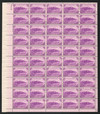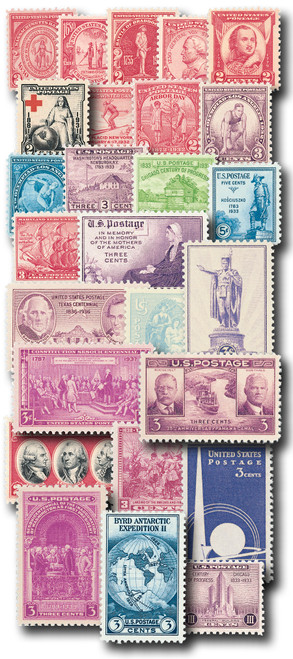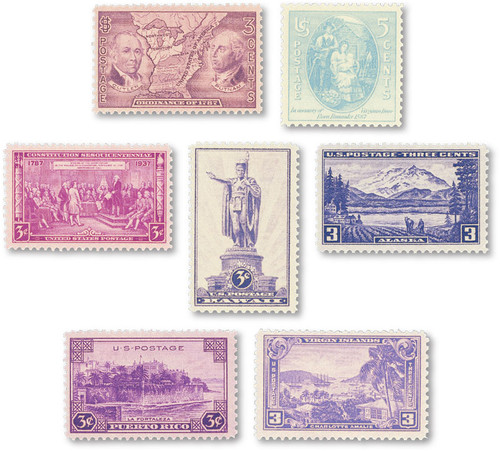
# 801 - 1937 3c Puerto Rico
1937 3¢ Puerto Rico Territory
First City: San Juan, Puerto Rico
Quantity Issued: 81,292,450
Printed by: Bureau of Engraving and Printing
Printing Method: Rotary Press
Perforation: 11x10 ½
Color: Bright violet
Territorial Series
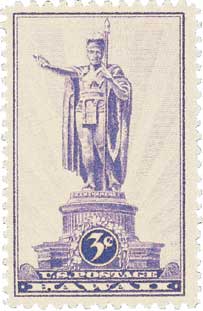
On October 18, 1937, the US Post Office issued the first stamp in a new series honoring the overseas territories of the United States.
The first stamp in the series was issued on October 18, 1937, in Honolulu Hawaii. It pictures a statue of King Kamehameha I, who united the Hawaiian Islands in 1810. Hawaii adopted its first constitution in 1840. And the United States recognized Hawaii as an independent government in 1842.
In 1893, Queen Liliuokalani attempted to install a new constitution that would increase her power, which led to a revolution that removed her from office. This led to the creation of the Republic of Hawaii before the islands came under the control of US businessmen.
These businessmen lobbied for Hawaii to be annexed by the US. On August 12, 1898, the islands were officially annexed and became US possessions. Hawaii became a US territory on June 14, 1900, making Hawaiians US citizens. It later achieved statehood in 1959.
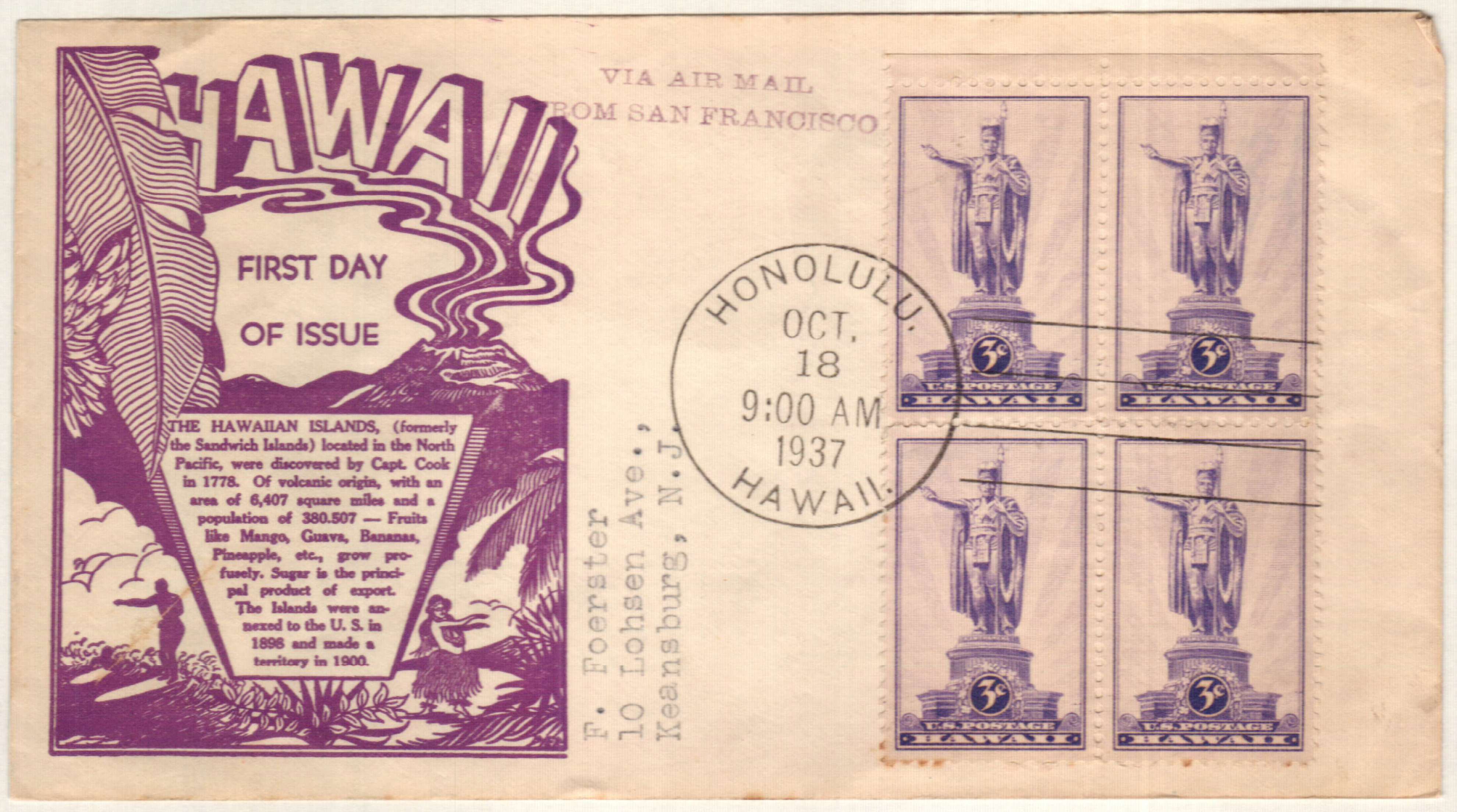
The second stamp in the series was issued on November 12, 1937, in Juneau, Alaska. It pictured Mount McKinley, a farm, and a village. Prior to US ownership, Alaska was owned by Russia. However, Russia’s attempts to establish coal mining, shipbuilding, and whaling industries there were unsuccessful, which led them to decide to sell the property.
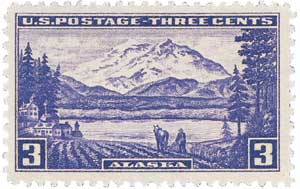
US Secretary of State William H. Seward agreed to buy Alaska for $7,200,000 – a cost of about 2¢ per acre. Today, with the perspective of history, Seward’s purchase is seen as a stroke of genius. At the time, many Americans opposed the purchase. In fact, some called it Seward’s Folly and referred to Alaska as Seward’s Icebox and Icebergia. However, not all Americans opposed the purchase, and Congress approved the treaty. On October 18, 1867, US troops raised the American flag at Sitka.
Gold discoveries helped convince detractors of Alaska’s worth and helped to increase the population. Ninety-one years after it became a territory, Alaska achieved statehood in 1958.
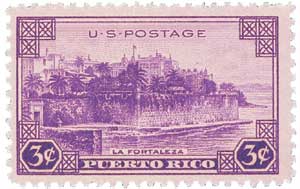
The third stamp in the series was issued on November 25, 1937, in San Juan, Puerto Rico. It shows La Fortaleza (the Fortress), in San Juan. Built in the 1530s, its one of the oldest buildings in the US and still serves as the official residence of the Governor of Puerto Rico. In nearly 500 years of defending San Juan Harbor, La Fortaleza has been captured only twice.

Puerto Rico had been a Spanish possession since the arrival of Christopher Columbus in 1493. By the late 1800s, the native inhabitants were unhappy with the conditions there and began to rebel. At the same time, similar uprisings were occurring in other Spanish territories and the US got involved, sparking the Spanish-American War. The war lasted just three months and resulted in the US acquiring Puerto Rico in 1898. In 1952, it became an autonomous Commonwealth in association with the United States.
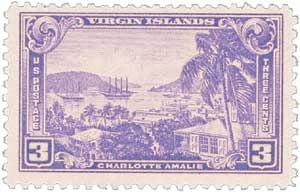
The final stamp in the series was issued on December 15, 1937, in Charlotte Amalie, US Virgin Islands. The stamp shows Charlotte Amalie Harbor, located on the island of St. Thomas.

In 1867, the United States wanted to purchase St. Thomas and St. John. A price of $7.5 million was agreed upon, but the deal fell through. Another attempt was made in 1902, but also failed. Finally, during World War I, American concerns grew that Germany would try to take over the Danish territories in the region. Denmark was badly in need of money due to the war, and in 1917 sold all three islands to the US for $25 million. The name was changed from the Danish West Indies to the US Virgin Islands. US Citizenship was granted to islanders in 1927, and the territory was governed by the US under the administration of the US Navy. The islands gained more self-governance in 1968 when Congress passed a law allowing them to elect their own governor, effective in 1970.
1937 3¢ Puerto Rico Territory
First City: San Juan, Puerto Rico
Quantity Issued: 81,292,450
Printed by: Bureau of Engraving and Printing
Printing Method: Rotary Press
Perforation: 11x10 ½
Color: Bright violet
Territorial Series

On October 18, 1937, the US Post Office issued the first stamp in a new series honoring the overseas territories of the United States.
The first stamp in the series was issued on October 18, 1937, in Honolulu Hawaii. It pictures a statue of King Kamehameha I, who united the Hawaiian Islands in 1810. Hawaii adopted its first constitution in 1840. And the United States recognized Hawaii as an independent government in 1842.
In 1893, Queen Liliuokalani attempted to install a new constitution that would increase her power, which led to a revolution that removed her from office. This led to the creation of the Republic of Hawaii before the islands came under the control of US businessmen.
These businessmen lobbied for Hawaii to be annexed by the US. On August 12, 1898, the islands were officially annexed and became US possessions. Hawaii became a US territory on June 14, 1900, making Hawaiians US citizens. It later achieved statehood in 1959.

The second stamp in the series was issued on November 12, 1937, in Juneau, Alaska. It pictured Mount McKinley, a farm, and a village. Prior to US ownership, Alaska was owned by Russia. However, Russia’s attempts to establish coal mining, shipbuilding, and whaling industries there were unsuccessful, which led them to decide to sell the property.

US Secretary of State William H. Seward agreed to buy Alaska for $7,200,000 – a cost of about 2¢ per acre. Today, with the perspective of history, Seward’s purchase is seen as a stroke of genius. At the time, many Americans opposed the purchase. In fact, some called it Seward’s Folly and referred to Alaska as Seward’s Icebox and Icebergia. However, not all Americans opposed the purchase, and Congress approved the treaty. On October 18, 1867, US troops raised the American flag at Sitka.
Gold discoveries helped convince detractors of Alaska’s worth and helped to increase the population. Ninety-one years after it became a territory, Alaska achieved statehood in 1958.

The third stamp in the series was issued on November 25, 1937, in San Juan, Puerto Rico. It shows La Fortaleza (the Fortress), in San Juan. Built in the 1530s, its one of the oldest buildings in the US and still serves as the official residence of the Governor of Puerto Rico. In nearly 500 years of defending San Juan Harbor, La Fortaleza has been captured only twice.

Puerto Rico had been a Spanish possession since the arrival of Christopher Columbus in 1493. By the late 1800s, the native inhabitants were unhappy with the conditions there and began to rebel. At the same time, similar uprisings were occurring in other Spanish territories and the US got involved, sparking the Spanish-American War. The war lasted just three months and resulted in the US acquiring Puerto Rico in 1898. In 1952, it became an autonomous Commonwealth in association with the United States.

The final stamp in the series was issued on December 15, 1937, in Charlotte Amalie, US Virgin Islands. The stamp shows Charlotte Amalie Harbor, located on the island of St. Thomas.

In 1867, the United States wanted to purchase St. Thomas and St. John. A price of $7.5 million was agreed upon, but the deal fell through. Another attempt was made in 1902, but also failed. Finally, during World War I, American concerns grew that Germany would try to take over the Danish territories in the region. Denmark was badly in need of money due to the war, and in 1917 sold all three islands to the US for $25 million. The name was changed from the Danish West Indies to the US Virgin Islands. US Citizenship was granted to islanders in 1927, and the territory was governed by the US under the administration of the US Navy. The islands gained more self-governance in 1968 when Congress passed a law allowing them to elect their own governor, effective in 1970.







